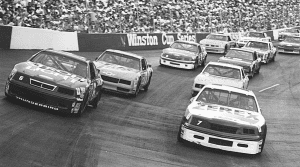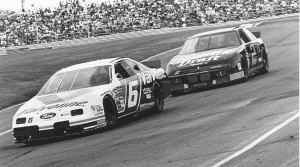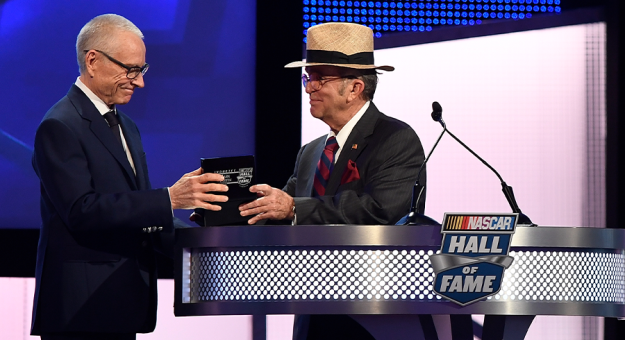Editor’s Note: This is the first of a four-part series on NASCAR Hall of Famer Mark Martin. Part two will run tomorrow.
For nearly 30 years, Mark Martin was one of NASCAR’s top drivers at the Cup Series level.
With 96 victories across NASCAR’s top three divisions, Martin made his mark on the sport.
However, the Batesville, Ark., native’s Hall of Fame career came from humble beginnings.
A graduate of the Midwest late model scene, Martin competed in five Cup Series races in 1981, earning two poles and two top-10 finishes. Though with limited resources, Martin’s chances of solidifying a solid ride in the series were slim.
“It looked good in 1981. But that was because I had time to prepare for every race in between races,” Martin said. “Whereas when I tried to run full time in 1982 with five employees and two race cars, you just can’t run the full schedule.”
But a call from SCCA and IMSA team owner Jack Roush flipped the script for then-29-year-old Martin in 1988.
“Steve Hmiel is one of my heroes in that story. Steve was paying attention to what I was doing all the way back in 1981,” Martin said. “Steve was at Pettys and it was such an honor for a guy with a Richard Petty uniform on to come over to my car and talk to me. Because Richard Petty was my favorite driver as a kid.
“So that was an honor and Steve had always kept an eye on me. So Steve, I think was kind of pro-me driving but, of course, Jack wanted experienced guys. He talked to Geoff Bodine, and Geoff didn’t show interest. He talked to Bobby Allison and Bobby was set.
“But what Bobby said was, ‘You know who you should get? Mark Martin.’

“If you want my opinion, I think I was pretty far down the pecking order. Not many people want to go drive for a Northerner for an upstart team. NASCAR was still fairly protective of its Southeastern roots. It wasn’t always easy for people from the outside of that to come in.
“Jack wasn’t known in the industry and he was going to be an upstart team,” Martin continued. “He also wasn’t going to pay anybody any money. With all those things considered, he didn’t have a lot of options for drivers.
“Most of these guys were more interested in driving for established teams. So I became the guy that I had been racing toward for three years,” Martin continued. “I was a little tiny contract driver for Ford. They were giving me just a little bit of help for my program. I was the highest on the list. I don’t know if anybody else was even on the list, because I was pretty far down.”
Thus, the Martin/Roush pairing was off and running in 1988. For Martin, the decision to join Roush came in part because it would be a stable organization with a two-year commitment.
“He was going to do everything in his power to have good engines because that was his business, was engineering and engines,” Martin said. “He laid out the program, he said we were going to test this many times, that we’re going to run a limited schedule. Not the full schedule, but we were going to test.
“Between him laying out the program, how he wasn’t going to hold back on getting the hardware and putting the tires on the car, and he had Steve Hmiel and Robin Pemberton, who I knew both, it was exciting to me. Besides, I didn’t have nothing and nobody was gonna give me a ride in Cup.
“I had been racing in the Busch Series that year, and the year before I got with Jack, I had won three races. So the Cup guys were starting to look over there that way, but nobody was gonna give me a ride. I had already been down there and tried in 1982 and ’83, and I had failed.”
With solid backing and belief behind him, Martin and the Roush Racing team saw immediate results. Their first Cup Series win came at Rockingham (N.C.) Speedway in 1989.
By 1990, the team was a threat every weekend, scoring three victories and 23 top-ten finishes, the No. 6 team finished second in points, in only their third season together.
What was the secret to success for Roush Racing?

“Jack Roush gave young guys who wanted it really bad and were willing to work their ass off, the tools that they needed to succeed, was basically what it was,” Martin said. “That pretty much lies initially on stage with Steve Hmiel’s shoulders, but is not limited to Steve. Robin, Tony Martin. There were only about eight guys. Dennis Ritchie, the truck driver. There were only eight guys the first year that worked there full time. They worked night and day.
“The reason we succeeded is because Jack gave us the tools, he did what he said. He bought the chassis. We hung the bodies on them and he built the motors for them. We tested and we busted our butt. It was how bad they wanted it, and how hard they work.”
Roush’s homegrown outlook on cultivating a strong team, struck a chord with Martin.
“If Jack Roush didn’t have any other success to stand on, he should be in the NASCAR Hall of Fame for the one reason alone, and that is if you look he never went out and stole an employee,” Martin said.
“He gave guys that he knew wanted it really bad, the tools that they needed to succeed. Look at all his drivers, look at all his crew chiefs. All those guys were guys that came up. He never grabbed one of Hendrick’s guys or Childress’ guys or somebody like that, drivers or crew chiefs or crew people. He looked for guys who wanted it and would work their guts out for it, because he was one of those guys himself.”
As Roush Racing was built from the ground up with the driver/owner duo of Martin and Roush, their eyes became focused on championships.
Near title bids in 1997, ’98 and 2002 slipped through the grasp of the No. 6 team. A large reason why, was the team pushing the envelope to find extra speed.
“We pushed Jack really hard to make more power. In doing so, we broke a lot,” Martin said. “In 1989, we weren’t pushing him for more power, and we didn’t break as much. That’s why we nearly won the championship. We nearly won the championship the next year in 1990.
“But in 1991, we started pushing him hard for more power and we started having some reliability issues. You couldn’t win the championship in 1998, because Jeff Gordon won 13 races. That wasn’t the right year to pick to win, we won seven. 2002, we should have won, or could have won, if we could have just kept the engine together, but we didn’t. 1997, actually, is an overlooked season as well. There again, if we could have just not broken one engine that would have made the difference.”
Despite the near misses, the title eluded the 2017 NASCAR Hall of Fame inductee.
“There were a lot of missed opportunities, but that’s not really what defines me,” Martin said. “What I’m proud of is the success that we had. I never did dwell on what we didn’t do. I’m just proud as hell of what we did do.”
As the sport evolved and grew in the early 2000s, so did Martin’s aspirations for a change.
Read more in part two — tomorrow.
Follow @DHoffmanMedia22